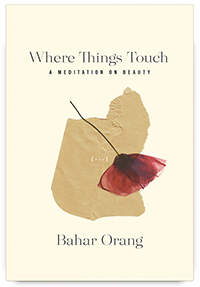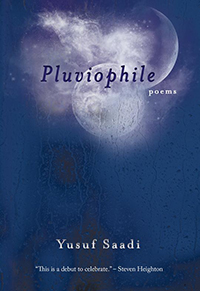Reviews
Poetry Reviews by Manahil Bandukwala
Bahar Orang, Where Things Touch: A Meditation on Beauty (Toronto: Book*hug, 2020). Paperbound, 114 pp., $20.
Yusuf Saadi, Pluviophile (Madeira Park: Nightwood, 2020). Paperbound, 80 pp., $18.95.
 In Where Things Touch: A Meditation on Beauty and Pluviophile, Bahar Orang and Yusuf Saadi take up different ways of understanding and encountering intangible and abstract concepts of beauty, love, and grief in intimate ways. These collections are sensual and lyrical, and see these themes linger and resurge. Both poets are skilled at offering glimpses into tender spaces that leave you to “uncage [your] imagination, / let it gorge on a trough of words,” as Saadi puts it.
In Where Things Touch: A Meditation on Beauty and Pluviophile, Bahar Orang and Yusuf Saadi take up different ways of understanding and encountering intangible and abstract concepts of beauty, love, and grief in intimate ways. These collections are sensual and lyrical, and see these themes linger and resurge. Both poets are skilled at offering glimpses into tender spaces that leave you to “uncage [your] imagination, / let it gorge on a trough of words,” as Saadi puts it.
Orang’s lyric-poem-essay, Where Things Touch, explores beauty and how it intersects with desire and queer love, as well as drawing from Orang’s practice as a physician. The closeness that medical students have with the body mirrors the closeness the speaker has with beauty and opening it up. Beauty moves beyond aesthetic as Orang explores the internal nature of what this intangible word is: “Beauty must be in conversation with care—there can be no alternative for me! So when I say beauty, I mean the slow approach of alive things, meeting each
other in all their complexity and longing.”
The collection has a loose narrative arc that follows different threads: getting to know a lover, practicing medicine, and remembering past experiences. Orang gives flashes of insight through prose-poem snippets. Encounters with beauty shift across the narrative: first come the aesthetics of beauty, and then, like a physician, the narrator opens beauty up to see and experience its internal workings. Many of the meditations on beauty reach a conclusion of beauty being in aliveness, in care, in connection. “Whatever beauty is, I know it has little to do with origins or symmetry.” The outward aesthetics of beauty take a back seat against the “beauty [of] restraint … the fruit of that restraint.” There is a quiet tension in the uneasiness of aspects of the
medical practice, like blood, against the uneasiness of accepting the past lovers of a current lover. “Another practice of beauty,” writes Orang, “yielding and unyielding to you.” The beauty of surrendering to and accepting the surrender of a lover. The trust that is wrapped up in what makes love beautiful.
No single word can encapsulate these abstractions that Orang seeks to tease apart. If the lyric essay ever reaches any sort of conclusion, it is in the lack of a fixed definition. Words offer an avenue to express love, desire, and intimate care, while also falling short on a surface level of such expressions. The following poem nestled in the middle of the collection seems to give an answer as to why Orang, poets more
broadly, and people ruminate on words so much: “well we don’t want to say I love you / it might be too easy, too much / instead we get inside the words, / to a naked centre, / finding all the ways to say / what you mean to me / (everything).” A collection devoted to a single word must break open the word itself. Is it possible to express the full extent of our emotions through words alone? Poetry as a medium breaks words and meanings open. It is concerned with what is left unsaid as much as it is with the direct words on the page, and so it becomes the ideal vehicle for articulations of love.
Orang intertwines love and beauty, and in the latter half of Where Things Touch, love almost displaces beauty as the central subject. “You know, despite everything I’ve said, I’m wary of wasting words on love. By which I mean, I have already written and rewritten letters of love to you in great repetition.” Orang has set up the slow trajectory from beauty to love so gradually, just like the gradual feeling of falling in love. The different aspects of beauty—care, familiarity, intimacy—come together to provide tangibility to not only the concept of beauty, but to love itself.
 Like Orang’s Where Things Touch, Saadi’s Pluviophile carries a tone of tenderness, care, and closeness throughout. New experiences of love are not removed from past and present grief. Both poets explore that grief as integral to the love and beauty that opens up across the narrative trajectories of these books. While beauty formed the basis of Orang’s meditations, the core images Saadi continues to return to are the moon, space, time, light, and art. Each section in Saadi’s book opens with a sonnet-like poem. These sonnets are the strongest and most evocative part of Pluviophile. The first poem, “Love Sonnet for Light,” reads, “I wish I could touch you – / not like two electrons repulsing, nor within / the semiotics of language, but hold you / how I hold a hand when I’m afraid.”
Like Orang’s Where Things Touch, Saadi’s Pluviophile carries a tone of tenderness, care, and closeness throughout. New experiences of love are not removed from past and present grief. Both poets explore that grief as integral to the love and beauty that opens up across the narrative trajectories of these books. While beauty formed the basis of Orang’s meditations, the core images Saadi continues to return to are the moon, space, time, light, and art. Each section in Saadi’s book opens with a sonnet-like poem. These sonnets are the strongest and most evocative part of Pluviophile. The first poem, “Love Sonnet for Light,” reads, “I wish I could touch you – / not like two electrons repulsing, nor within / the semiotics of language, but hold you / how I hold a hand when I’m afraid.”
Not all of Saadi’s sonnets rhyme, but “Root Canal” does, and demonstrates his mastery over language as he subtly rhymes “croon” with “paan.” This poem, whose title holds associations of pain, reads, “In my mother’s tongue I love / you intimates I want you as my home.” The sonnet’s structure leaves “love” and “home” as rhyming lines, delving into the relationship between love, home, and care. Many poems demand to be read aloud as that act reveals the ways Saadi plays with language and rhyme. The sonnets are a good example of this, but so is “Glossary of Air,” which plays with structure and space in interesting ways. Like many of the poems in Pluviophile, this one demands to be read over and over again:
Never Perhaps language feels
unreal because we hold onto words
but touch them
The fill-in-the-blank structure of this poem settles in at a slow place, like the slow flood of light over gilded floors in “Love Sonnet for Light.”
In the ghazal, “For the Girl Who Doesn’t Believe in Time,” space, the universe, language, and beauty merge. “You said a perception’s not an experience, / only minor poets make love to time,” writes Saadi. Like Orang’s meditations on beauty, the recurring language and images strengthen and enhance the ruminations on connection and cosmology in Pluviophile. Saadi likewise has his own meditations on
beauty: “a girl sketches clouds on stone / floors in Viswa Bharati—smudges their edges for aesthetic / effect, wonders if humans alone feel beauty, how pathetic / pathos is, if two field cows bellowing different pitches / mean music,” he writes in “Foreshadows.” Reading Where Things Touch along with Pluviophile gives this question of whether only humans feel beauty an elevated significance. Orang’s meditations on beauty are focused on an intensely human experience of beauty, while Saadi opens up the questions of non-human encounters with the concept.
Even in a collection that precisely cuts open the abstract concept of beauty, Orang has not exhausted the possibilities of its meanings. The conclusion she reaches reads as an open-ended invitation to explore and ruminate on the different possibilities of beauty. Unintentionally, Saadi’s collection takes up this task through meditations and questions on art and home as they relate to beauty. Orang and Saadi both demonstrate the powerful capabilities of poetry and language to strike an ideal balance when it comes to expressions of intense emotions. Where Things Touch and Pluviophile grapple with the intersections of loss and grief with joy, beauty, and love that result in a space of trust and intimacy.
—Manahil Bandukwala









